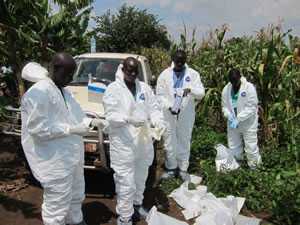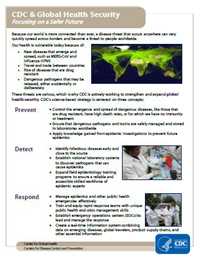Global Health Security: About Us
What We Do: Prepare Countries to Prevent, Detect, and Respond to Global Health Threats
In the fight against infectious diseases, no nation can stand alone. When it takes less than 36 hours for an outbreak to spread from a remote village to any major city in the world, protecting our health and national security means making sure other countries have the knowledge and resources to stop threats before they can spread beyond their borders. Together, we must build these first lines of defense to better prevent, detect, and respond to disease.
Protecting Americans’ health includes strengthening global health security. The Division of Global Health Protection (DGHP) leads CDC’s global health security efforts, working with our partner countries to help build the core public health capacities that are needed to identify and contain outbreaks before they become epidemics that could affect us all.
Why It’s Important
Health Security is a National Security Issue
Not only does investment in global health security help prevent threats from reaching our shores, it also promotes economic and political stability in the U.S. and around the world.
From Avian Flu, to Zika, to drug-resistant bacteria, the world faces a host of dangerous pathogens and potential epidemics. New diseases, like MERS-CoV and influenza H7N9, can emerge without warning and quickly spread. In our globally connected world, their effects have unprecedented reach.
A changing world means our risk is greater than ever. The ease of global travel means there are more opportunities for disease to spread; the increasing urbanization of the world means that there’s more potential for diseases to emerge and strike in densely populated areas; and the disturbing but real threat of disease used as an instrument of terror requires us to have faster, more thorough, and more adaptive capabilities.
We know we can effectively stop outbreaks and save lives, even when the disease is fast-moving and deadly. Investments in core areas of public health have already made a difference in stopping deadly outbreaks like Ebola in Nigeria, Polio in Mali, Yellow Fever in Angola, and Avian Flu in Cameroon.
However, across the globe, dangerous gaps in public health systems still exist. About 70% of the world’s countries report that they are not fully prepared for an outbreak.
Outbreaks can start anywhere and spread across the globe almost overnight, with devastating results1. In 2003, an outbreak of severe acute respiratory syndrome (SARS) infected approximately 8,100 people, killed more than 700, and reached more than two dozen countries, heightening the world’s awareness that we must all work together to stop diseases from spreading.
The 2014-2016 Ebola epidemic in West Africa is the most recent – and tragic – example of the urgent need for all countries to strengthen their public health systems. This epidemic was the first time Ebola spread into urban areas, and it reached 10 countries and killed more than 11,000 people before its end, disrupting global travel and trade and costing the world billions. It’s estimated that the next global pandemic could cost the world upwards of $60 billion.
How We Do It
We lead CDC’s efforts toward helping our 31 partner countries meet the goals of the Global Health Security Agenda. The Global Health Security Agenda aims to close gaps in preparedness and accelerate progress toward a world safe and secure from infectious disease threats.
This work is critical to protecting health in the United States and around the world and is focused on:
- Disease surveillance and outbreak response, including establishing routine surveillance for priority diseases and developing information technology tools and systems
- Emergency management, ensuring countries have the knowledge and resources they need, including emergency operations centers that can mount a fast, coordinated response when outbreaks happen
- Safe laboratory systems and diagnostics, building the capacity to identify disease threats close to the source and inform decision-making
- Developing the workforce, training frontline responders, laboratorians, disease detectives, emergency managers, and other health professionals who are responsible for taking the lead when crisis strikes
Building global health security can’t be accomplished alone. We work closely with key CDC programs; other U.S. government agencies; ministries of health; and international organizations to accomplish global health security goals. We send world-class experts from across CDC into the field, where they share knowledge and gain on-the-ground experience that better prepares us to handle health threats at home in the U.S.
We build on the work already being done in countries to be as efficient and effective as possible. We promote mutual strategies, research, and policies to ensure that our partner countries are well prepared to respond to disease threats, wherever they might begin.
The Global Health Security Agenda
Designed to help countries meet their commitments under the International Health Regulations, the Global Health Security Agenda (GHSA) is a worldwide effort to strengthen countries’ public health capacity to prevent, detect, and respond to infectious disease threats. Today, CDC is partnering with 31 countries around the world to reach the goals of the GHSA.
In a world where diseases can spread faster and more unpredictably than ever before, GHSA sets out clear, attainable, and measurable targets for countries to improve their public health systems and better prepare against outbreaks.
To measure countries’ progress towards meeting GHSA goals, CDC and its partners developed the Joint External Evaluation (JEE). The JEE is a voluntary evaluation process that gives countries a starting point for improving their health security by identifying their strengths and pointing out the most urgent needs within their health systems2. This transparent, external evaluation process encourages countries to share vital information with each other and work together towards a safer, healthier world.
Where We Work

Responders from the Uganda Red Cross put on their personal protective equipment before responding to a reported death in a village.
CDC is currently helping partner countries meet their global health security targets, supporting the U.S. goal of assisting 31 countries: Bangladesh, Burkina Faso, Cambodia, Cameroon, Cote d’Ivoire, Democratic Republic of Congo, Ethiopia, Georgia, Ghana, Guinea, Haiti, India, Indonesia, Jordan, Kazakhstan, Kenya, Laos, Liberia, Malaysia, Mali, Mozambique, Pakistan, Peru, Rwanda, Senegal, Sierra Leone, Tanzania, Thailand, Uganda, Ukraine, and Vietnam. In addition, we’ve partnered with the Caribbean Community (CARICOM) and the Caribbean Public Health Agency (CARPHA) to identify global health vulnerabilities in the Caribbean and are developing a plan to address them.
In addition, we’ve also helped establish disease detection and response capabilities in other countries that were identified as at-risk from the Ebola epidemic. These countries are: Benin, Democratic Republic of the Congo, Gambia, Ghana, Guinea-Bissau, Mauritania, Nigeria, and Togo.
Fast Facts
- The U.S. is working in partnership with 31 countries, including 17 priority countries, to meet GHSA goals
- The 11 “Action Packages” outlined in the GHSA give participating countries focused, measurable targets to reach
- Our work strengthens 4 critical areas that form the core of public health: Surveillance, Laboratory, Workforce Development, and Emergency Operations Centers
- As of May 2017, 41 Joint External Evaluations had been completed worldwide, with an additional 23 planned for the remainder of 2017
Our Organization
We integrate CDC’s programs and experts with host countries to build capacities in surveillance, disease detection, and outbreak response, including:
- Global Disease Detection Program
- Global Disease Detection Operations Center
- Field Epidemiology Training Program
- Emergency Response and Recovery
- Global Public Health Informatics Program
- Center for Global Health
- National Center for Emerging and Zoonotic Infectious Diseases
- National Center for Immunization and Respiratory Diseases
- Office of Public Health Preparedness and Response
References
- Dr. Tom Frieden. Dr. Tom Frieden: Protecting the World from the Next Pandemic. GE Reports, 10/29/2015. Page accessed 5/12/2017.
- WHO. IHR (2005) Monitoring and Evaluation framework Joint External Evaluation tool (JEE tool). Page accessed 5/12/2017.
- Page last reviewed: May 12, 2017
- Page last updated: May 12, 2017
- Content source:


 ShareCompartir
ShareCompartir
